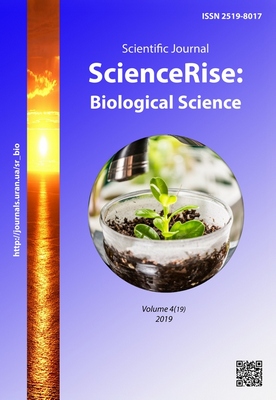Comparative assessment of methods for evaluation of drought tolerance in winter bread wheat varieties
DOI:
https://doi.org/10.15587/2519-8025.2019.186813Keywords:
winter bread wheat, water deficit, callus culture, seeds, mannitol, toleranceAbstract
The aim of the work was to estimate the drought tolerance of winter bread wheat varieties by the laboratory method and in vitro culture and to compare the obtained results.
Materials and methods. The object of research was winter bread wheat varieties of various ecological and geographical origins. In the work methods of tissue and organ in vitro culture, in vitro selection, laboratory and statistical data analysis were applied. The resistance to water deficit of 15 wheat varieties was studied by seed germination in the osmotic solution and the proportion of living calli on a selective medium with mannitol.
Results. The winter bread wheat varieties, created in various ecological zones, were screened for drought tolerance and sources of tolerance to water deficit were identified. The genotypic reaction to osmotic stress of the varieties was manifested by different proportions of viable calli and different percentage of germinated seeds under the action of the stress factor. It was established, that the Balada Myronivska and Gorlytsya Myronivska varieties were characterized by the highest tolerance to water deficit, in which the percentage of seed germination and callus survival on media with osmotic was the highest. The Ovidii and Wenzell varieties turned out to be the most sensitive to the action of water deficit, because under selective conditions they had the lowest tolerance to the osmotic stress. A reliable correlation was revealed (r = 0.86) between the drought tolerance indices, obtained by the laboratory method and in vitro. A method for assessing the drought tolerance of wheat genotypes has been developed and patented, which will contribute to the creation of new varieties with valuable practical properties.
Conclusions. The tolerance indices, obtained at various levels of organization (cells, seedlings), basically coincided for the majority of the studied varieties; therefore, in vitro and laboratory assessment methods can be used to evaluate breeding material. The possibility of using selective systems with mannitol for screening wheat genotypes for tolerance to water deficit is shown. The Balada Myronіvska and Gorlytsia Myronіvska varieties can be a valuable source material for further selection of wheat
References
- Cherenkov, A. V., Hasanova, I. I., Solodushko, M. M. (2014). Winter wheat – the development and selection of culture in historical perspective. Bulletin Institute of agriculture of steppe zone NAAS of Ukraine, 6, 3–8.
- Bartels, D., Sunkar, R. (2005). Drought and Salt Tolerance in Plants. Critical Reviews in Plant Sciences, 24 (1), 23–58. doi: http://doi.org/10.1080/07352680590910410
- Farshadfar, E., Jamshidi, B., Cheghamirza, K., da Silva, J. A. T. (2012). Evaluation of drought tolerance in bread wheat (Triticum aestivum L.) using in vivo and in vitro techniques. Annals of Biological Research, 3 (1), 465–476.
- Varavkyn, V. A., Taran, N. Yu. (2014). Diagnosis of drought resistance of wheat varieties of different breeding on osmoregulatory properties of seeds. ScienceRise, 3 (1 (3)), 18–22. doi: http://doi.org/10.15587/2313-8416.2014.27463
- Prokopik, N. I., Chugunkova, T. V., Khomenko, S. O. (2019). Estimation of drought toleranse of bread winter wheat varietis of different ecological and geografical under osmotic stress. Scientific Reports of NULES of Ukraine, 3 (79). doi: http://doi.org/10.31548/dopovidi2019.03.004
- Yurchenko, T. V., Demydov, O. A., Pykalo, S. V., Prokopik, N. I., Fomaniuk, V. A. (2019). Pat. No. 132899 UA. Sposib otsinky henotypiv pshenytsi miakoi ozymoi do dii vodnoho defitsytu. MPK: A01H 1/04; No. u201811089; declareted: 09.11.2018; published: 11.03.2019, Bul. No. 5.
- Dubrovna, O. V. (2017). In vitro selection of wheat for resistance to abiotic stress factors. Plant Physiology and Genetics, 49 (4), 279–292.
- Tagimanova, D. S., Ergalieva, A. Zh., Rayzer, O. B., Khapilina, O. N. (2013). Assessment of spring bread wheat genotypes for drought tolerance in vitro. Eurasian Journal of Applied Biotechnology, 2, 42–46. doi: http://doi.org/10.11134/btp.2.2013.7
- Rosseev, V. M., Belan, I. A., Rosseeva, L. P. (2011). In vitro testing of spring bread wheat for drought tolerance. Bulletin of altai state agricultural university, 76 (2), 32–34.
- Murashige, T., Skoog, F. (1962). A Revised Medium for Rapid Growth and Bio Assays with Tobacco Tissue Cultures. Physiologia Plantarum, 15 (3), 473–497. doi: http://doi.org/10.1111/j.1399-3054.1962.tb08052.x
Downloads
Published
How to Cite
Issue
Section
License
Copyright (c) 2019 Serhii Pykalo, Oleksandr Demydov, Tetiana Yurchenko, Nataliia Prokopik, Mykhailo Kharchenko

This work is licensed under a Creative Commons Attribution 4.0 International License.
Our journal abides by the Creative Commons CC BY copyright rights and permissions for open access journals.
Authors, who are published in this journal, agree to the following conditions:
1. The authors reserve the right to authorship of the work and pass the first publication right of this work to the journal under the terms of a Creative Commons CC BY, which allows others to freely distribute the published research with the obligatory reference to the authors of the original work and the first publication of the work in this journal.
2. The authors have the right to conclude separate supplement agreements that relate to non-exclusive work distribution in the form in which it has been published by the journal (for example, to upload the work to the online storage of the journal or publish it as part of a monograph), provided that the reference to the first publication of the work in this journal is included.









